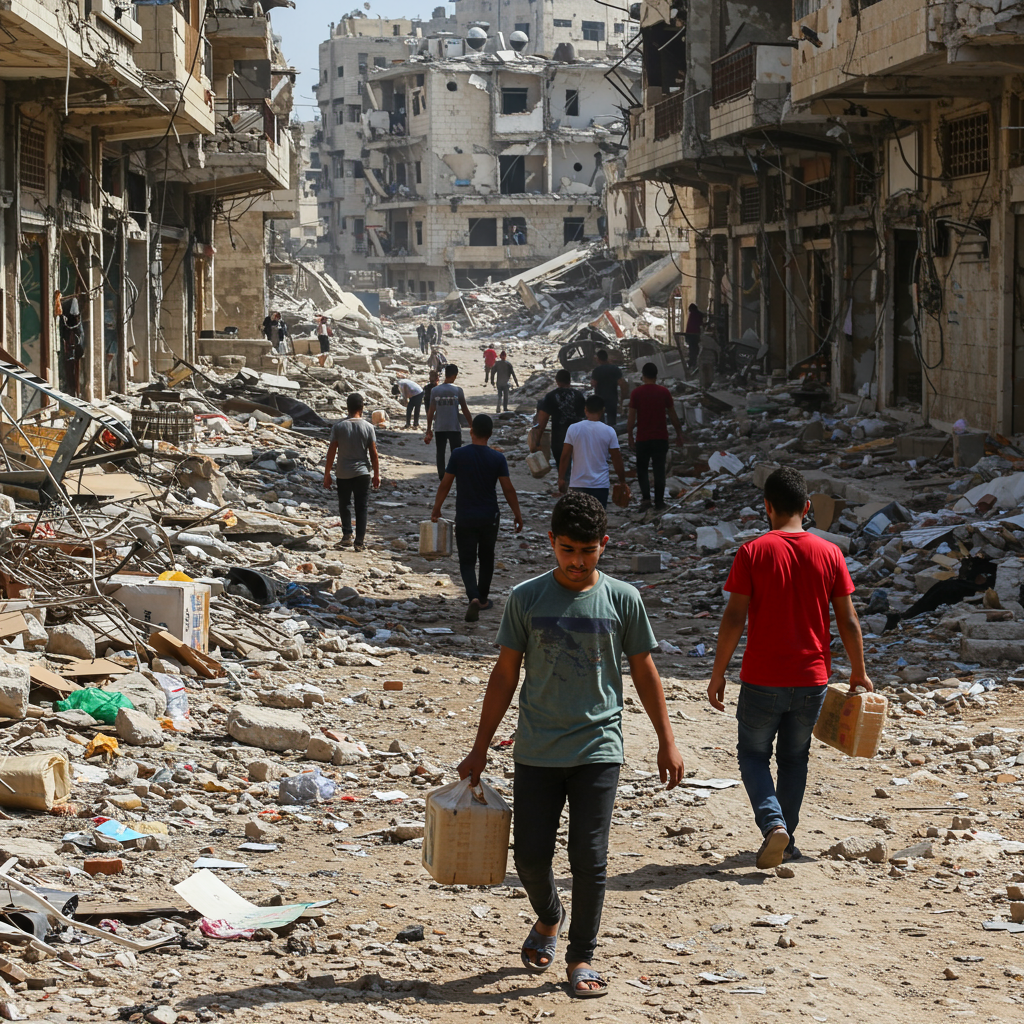In Gaza, the desperate search for food has become a daily ordeal fraught with deadly peril. Palestinians face a harrowing journey each day, navigating treacherous paths where the threats of gunfire from Israeli troops and ambushes by knife-wielding thieves loom large. This brutal reality forces individuals into a desperate competition for scarce resources, breeding lawlessness amidst profound suffering.
Securing food means risking everything for a chance at obtaining meager supplies – perhaps a bag of lentils, a jar of spread, or a sack of flour. Many return empty-handed, compelled to face the dangers again the next day. The situation is so dire that a UN humanitarian affairs spokesperson described it as “apocalyptic,” lamenting how it continues to worsen.
Facing the “Deadly Gantlet”
The journey to food distribution points is often likened to a “deadly gantlet” or even the survival challenges depicted in the dystopian series “Squid Game,” where simply raising one’s head can invite disaster. Thousands must walk miles, frequently entering areas designated as Israeli military zones, to reach aid centers.
Palestinians and Gaza’s Health Ministry report horrific violence along these routes. Daily gunfire from Israeli forces towards crowds heading to distribution sites has resulted in hundreds killed and wounded in recent weeks, according to the ministry. Witnesses describe heavy barrages from tanks, snipers, drones, and even crane-mounted guns, often targeting people attempting to pass certain points before centers open or deviating from narrow, designated paths. While the Israeli military claims its forces fire only warning shots at suspects approaching their positions, Palestinian accounts paint a starkly different picture of indiscriminate fire.
In one particularly tragic incident near UN aid trucks, over 50 people were reportedly killed in a single day due to Israeli fire, a claim the Israeli military stated it was investigating. GHF, a private contractor operating several distribution hubs, also denies shootings occur near its sites, attributing incidents to aid-seekers moving improperly or attempting shortcuts. They state efforts are underway to improve safety, including adjusting operating hours.
Personal Stories of Survival and Loss
The human cost of this desperate hunt is immense. Jamil Atili, 51, showed a knife cut across his cheek sustained in the frantic scramble for food. Despite the injury and being pepper-sprayed, he returned empty-handed to his 13 family members. “This isn’t aid. It’s humiliation. It’s death,” he stated, heartbroken at having nothing to feed his children.
Mohammed Saqer, a father of three, recounted crawling forward under tank fire, ducking when shots rang out, and discovering a young man shot in the back. He helped carry the wounded man to safety before joining the “crazed run” towards the distribution site, witnessing others injured and left behind in the rush. “Everyone is just running to get to the aid, to get there first,” he explained.
Omar al-Hobi, 43, shared similar harrowing experiences, enduring tank fire and seeing people shot, some apparently fatally. Frozen by horror, he was driven forward only by the thought of feeding his children.
The Chaotic Scramble and Pervasive Theft
Once inside the fenced distribution areas, the scene is a frantic melee as thousands desperately grab food boxes. Speed is critical not only to secure supplies before they run out but also to avoid the rampant theft that occurs outside. Thieves lie in wait, targeting those leaving, particularly those who were slower or less successful.
To avoid the main exit route where thieves gather, some, like Saqer, risk climbing over earthen berms, knowing this could potentially draw Israeli fire. Heba Jouda witnessed a group of men brutally beating a 12-year-old boy and stealing his food. Another time, she saw thieves attack an older man, slicing his arm with a knife to take his sack of food despite his tearful pleas.
Even if food is obtained after surviving the journey and the melee, the supplies are often meager and must be severely rationed to last days. Omar al-Hobi’s wife expressed immense relief when he returned alive, hoping he wouldn’t have to face the danger again.
A Breakdown of Humanity
Beyond the physical dangers, the daily struggle inflicts deep psychological wounds. Individuals are shaken not only by brushes with death but also by the callousness that permeates the desperate search for survival. Al-Hobi noted the grim reality: “No one will show you mercy these days. Everybody fends for themselves.”
The aid distribution system remains strained. Israel began allowing some food into Gaza after a 10-week complete cutoff, but UN officials maintain it’s insufficient to prevent starvation. Most aid is routed through GHF, which operates within or near Israeli military zones, while a smaller portion reaches the UN and other groups. Israel has reportedly indicated an intention for GHF to replace the UN network, alleging Hamas diverts UN aid – a claim the UN denies.
Ultimately, for Palestinians in Gaza, the act of seeking food is not a simple logistical challenge but a brutal, life-threatening ordeal, highlighting the dire humanitarian crisis gripping the enclave.



